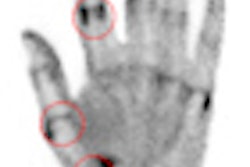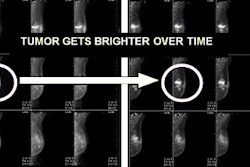Positron emission mammography (PEM) has improved specificity compared with MR imaging and is less likely to prompt unnecessary biopsies, according to a new study conducted by researchers at the American College of Radiology Imaging Network (ACRIN) in Lutherville, MD, and published online November 12 in Radiology.
Wendie Berg, MD, PhD, and colleagues compared PEM's performance and effect on surgical management to that of breast MRI in a cohort of 472 women with ipsilateral breast cancer. The women were 25 years of age or older, with newly diagnosed invasive and/or intraductal breast cancer that had been found at biopsy.
Between September 2006 and November 2008, the women underwent both bilateral contrast-enhanced MRI and FDG-PEM exams in random order, within five business days of each other, and without consideration of timing in the women's menstrual cycle.
Of the total cohort, 388 women completed the study; median tumor size was 1.5 cm. Of the 388 women, 271 (70%) underwent digital mammography and 117 (30%) underwent film-screen mammography before the study started. The exams found additional cancers in the alternate breast in 82 women: 49 (60%) of these additional cancers were found by MRI, 42 (51%) were found with PEM, and 22 (27%) were found via conventional imaging review. The median tumor size of these cancers was 0.7 cm.
Of the 82 additional cancers, MRI alone found 21 (26%), PEM alone found 14 (17%), and MRI and PEM together found 28 (34%). Review of the original, conventional mammography and ultrasound exams found seven (8.5%).
Adding conventional image review to either MR imaging or PEM improved sensitivity compared to using one of these two modalities alone, Berg's team found, and integrating PEM and MR findings improved the detection of additional cancer, from 49 of the 82 cancers (60%) with MR imaging alone, to 61 of the 82 cancers (74%).
Of the 388 women who participated in the study, 56 (14%) needed mastectomy based on the extent of their cancer. Of these 56, 40 were correctly identified with MR imaging, 20 were correctly identified with PEM, 18 were correctly identified with both MR and PEM, and two were correctly identified with PEM only.
PEM was more specific at detecting benign lesions, according to Berg, finding 151 of 189 benign lesions compared to MR's 124 of 189 -- a finding that could reduce unnecessary biopsies. The technology was less sensitive than MR at finding malignant lesions (47 out of 116, compared to MR's 61 out of 116).
Overall, PEM proved complementary to breast MRI, suggesting that it could be a good alternative for women who cannot tolerate MR, according to Berg. The study results also suggest that a coordinated review of all breast imaging studies at the time of PEM or MR image interpretation is important for improved diagnosis, she wrote.
The study was funded in part by PET developer Naviscan of San Diego, which provided the PEM device that was used (Berg is a consultant with the company).
By Kate Madden Yee
AuntMinnie.com staff writer
November 15, 2010
Related Reading
Positron emission mammography can be more specific than MRI, November 10, 2010
PEM shows potential for breast cancer surgical planning, November 10, 2010
Naviscan touts PEM study results, September 28, 2010
MBI casts wider net for improved breast cancer diagnosis, September 14, 2010
MBI could help breast centers caught in economic squeeze, September 14, 2010
Copyright © 2010 AuntMinnie.com




















